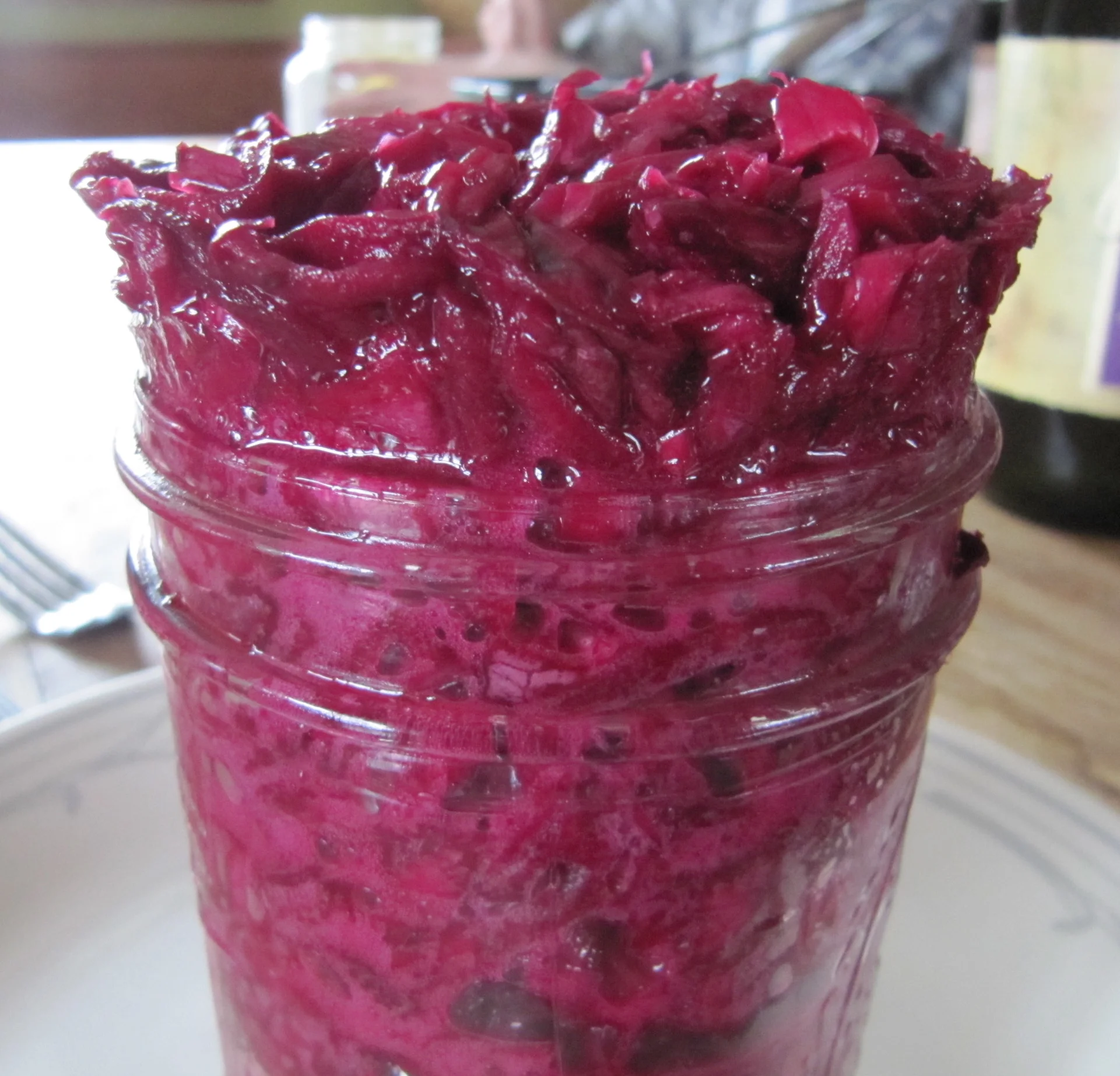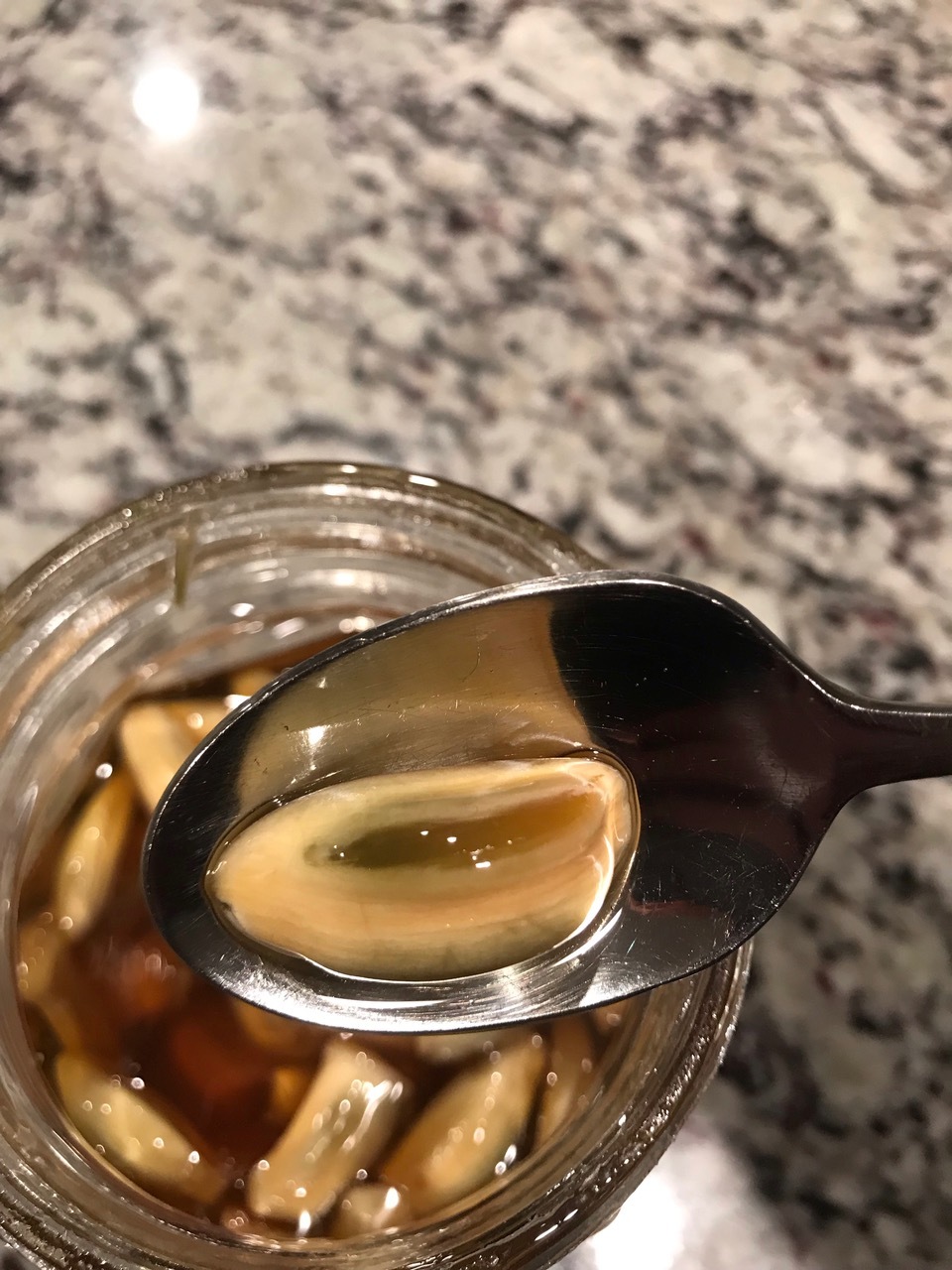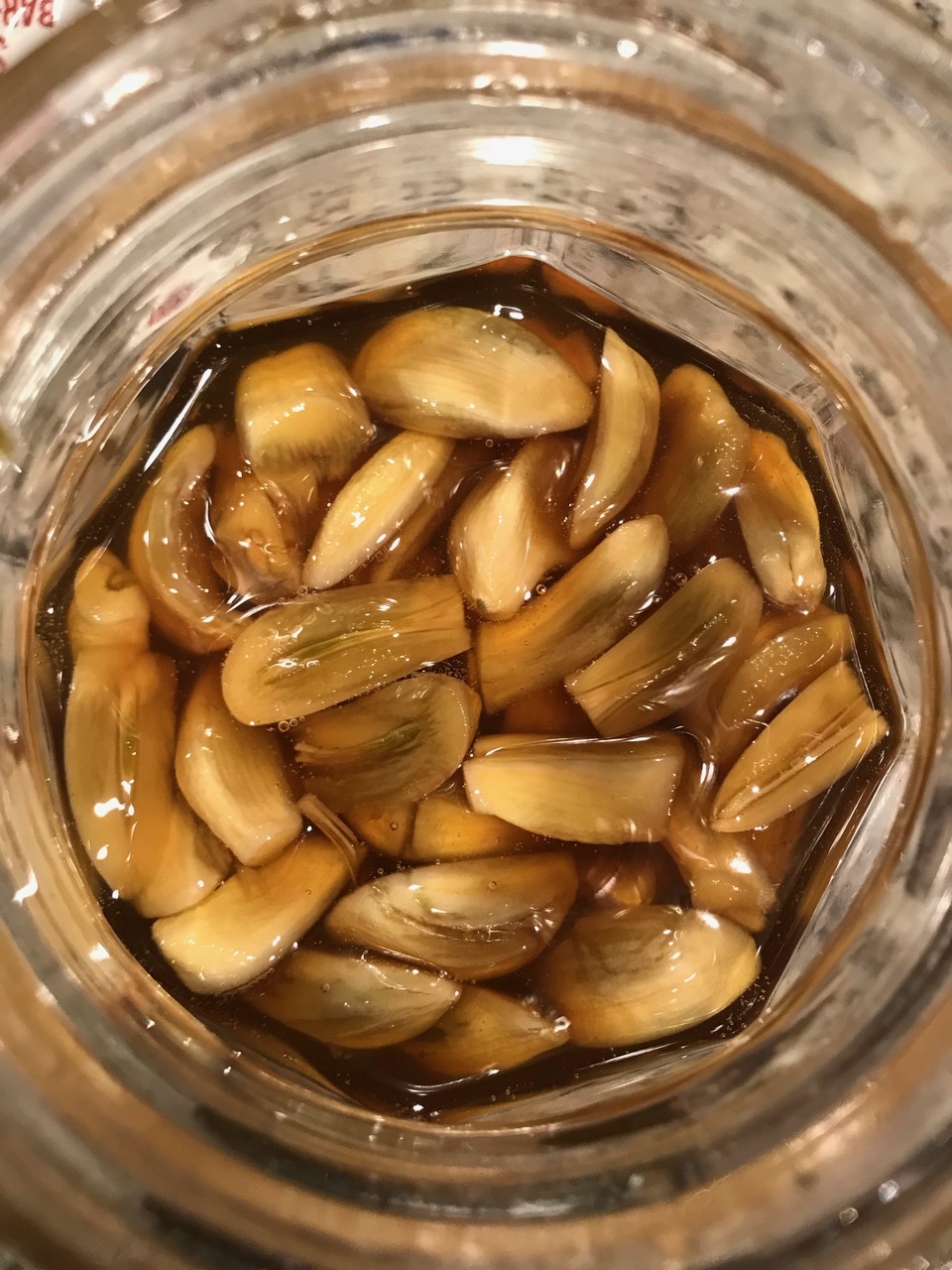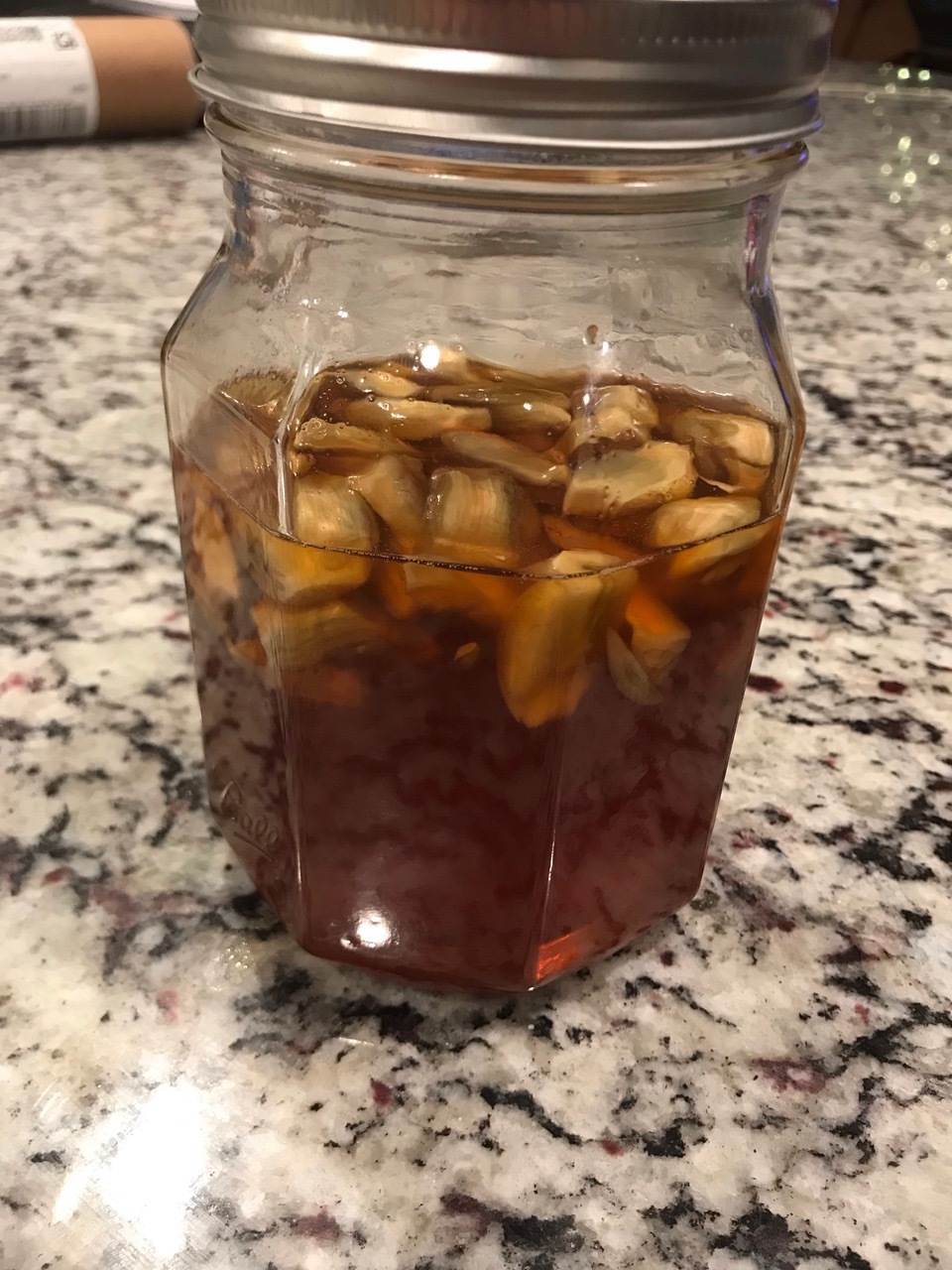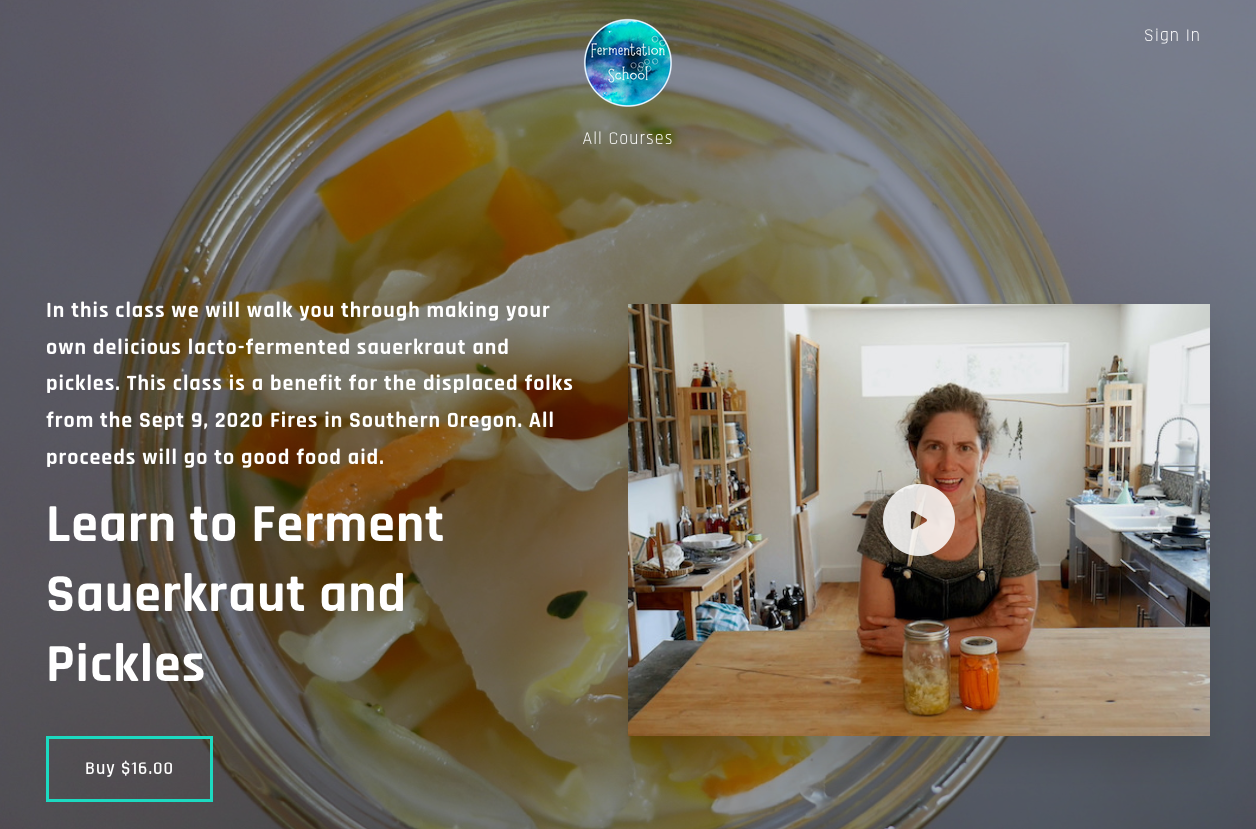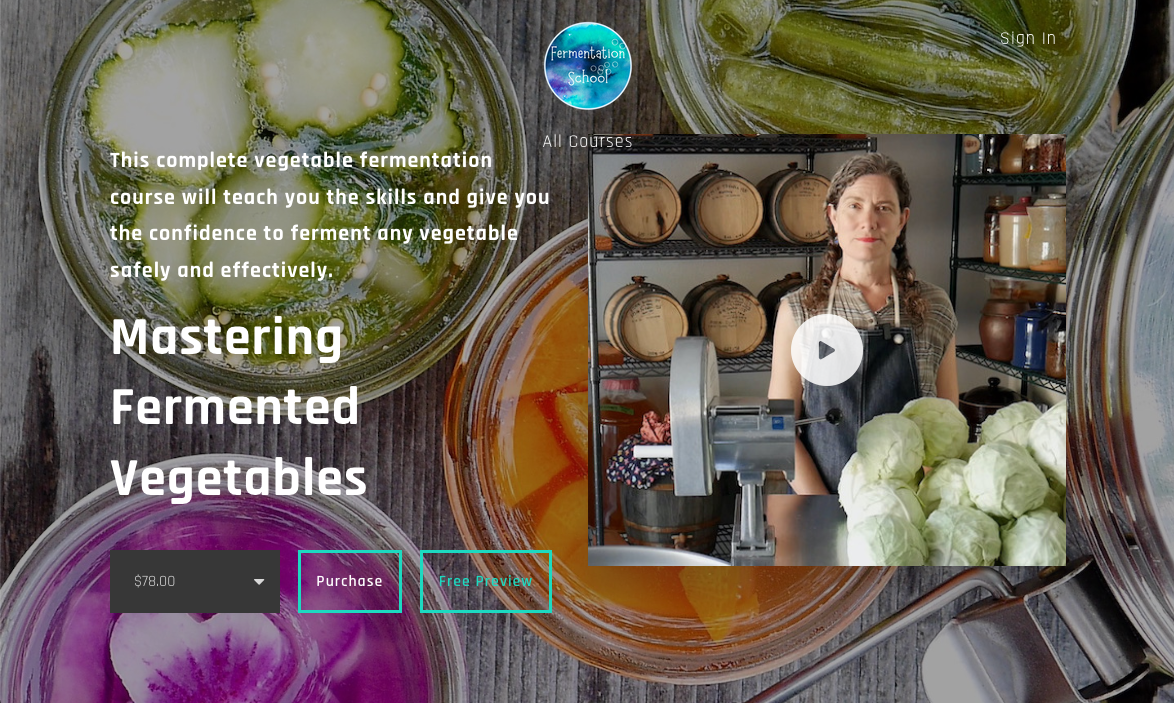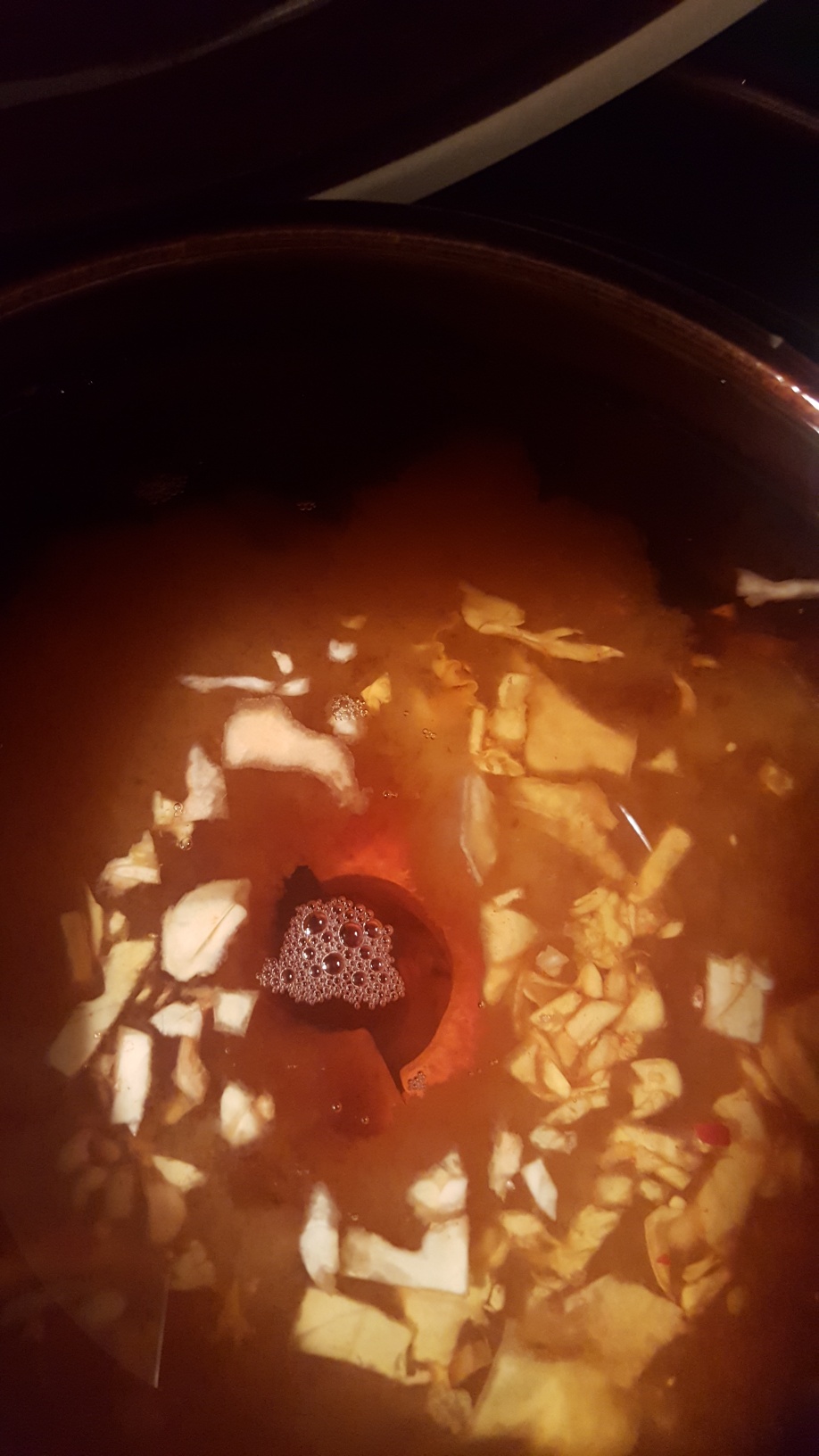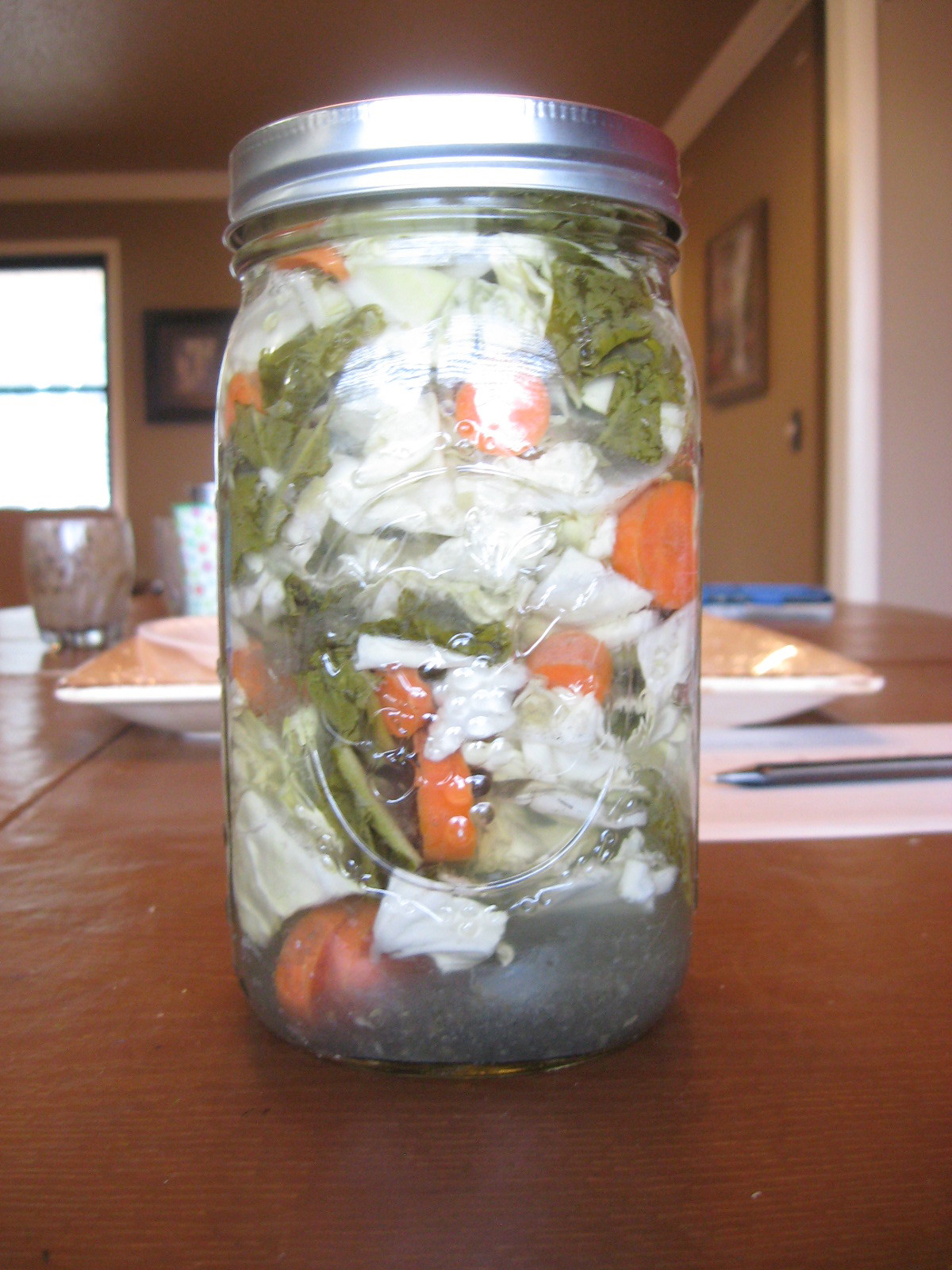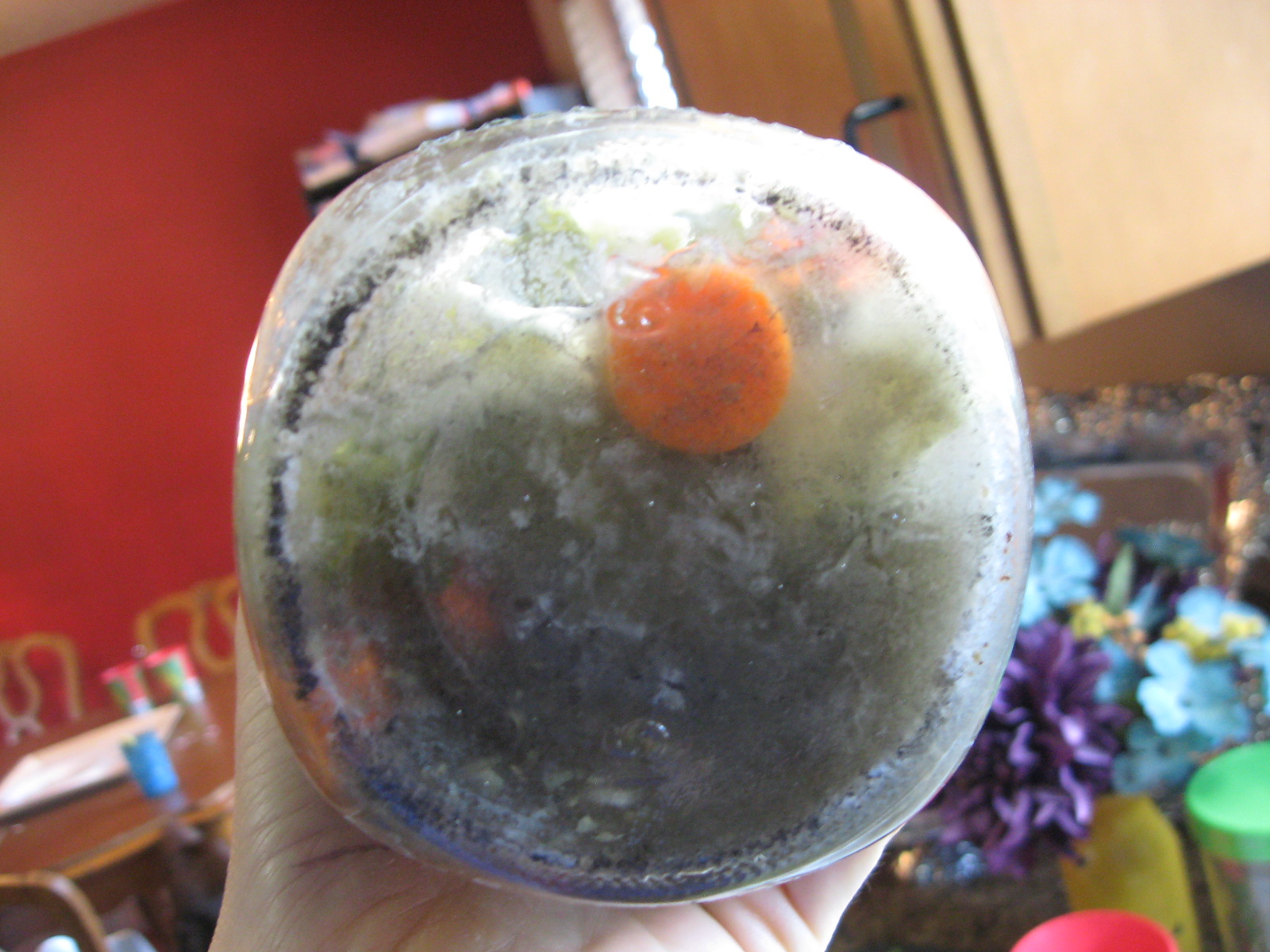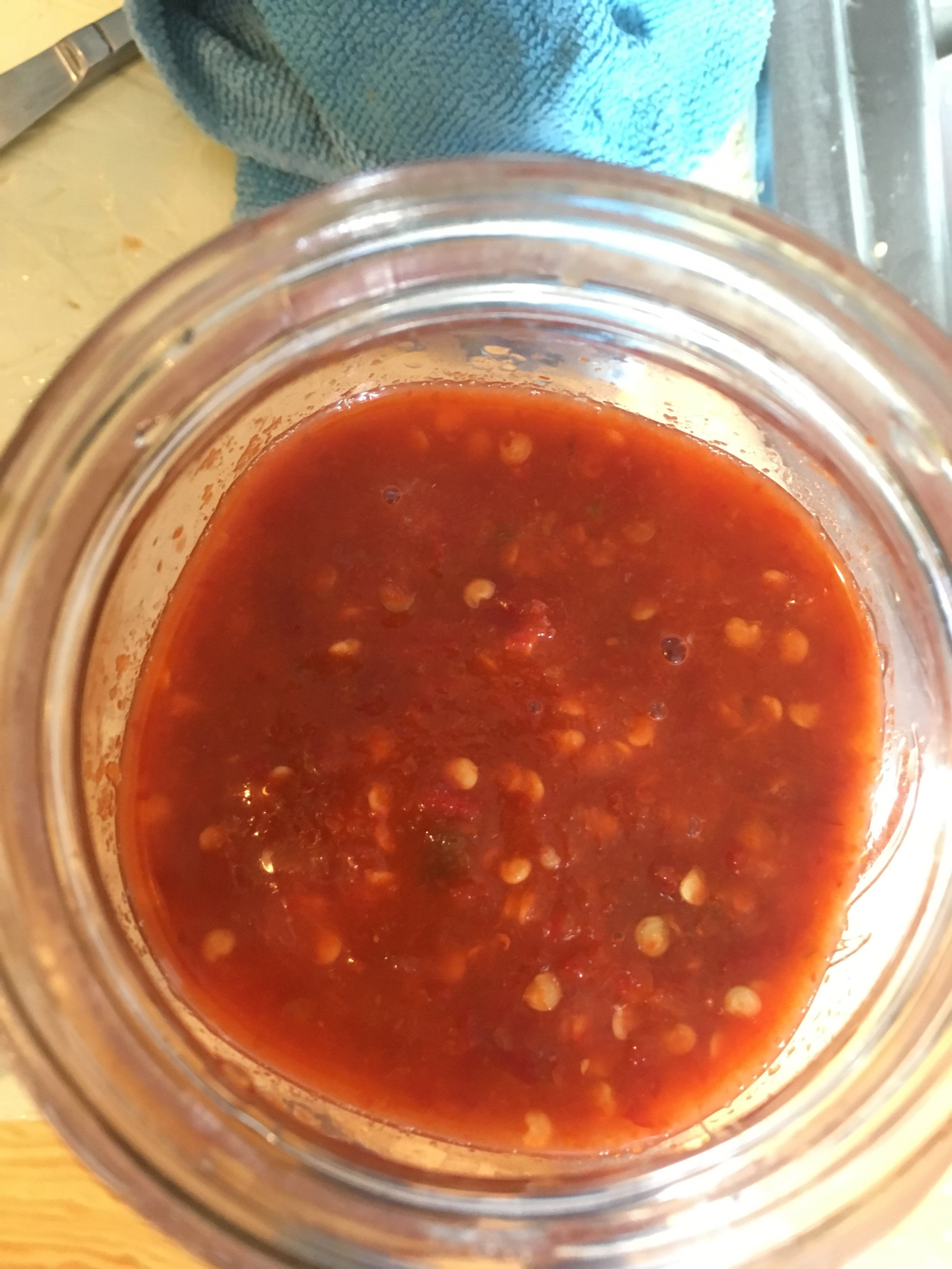Hi!
My name is Dalton and my fiancé and I have started our journey into the world of fermentation! That being said we started with the simple garlic honey ferment but I’m getting worried about the look the garlic seems to be taking on.
I’ve had some of the honey and I tried a garlic clove about 6 days ago and both were very good. But the farther along it gets the more the color is turning grey/dark and to me it looks strange. Is this ok to eat or does it mean the garlic is going rotten and we should start again?!
Thanks for any advice you can offer!
***********************
Hey Dalton,
Nice to hear from you—welcome to the fermentation journey. It is a good one.
The color of the garlic will continue to get darker over time and that is perfectly normal. Go ahead and eat and enjoy your honey and your garlic.
Cheers,
Kirsten
Why Would Fermented Green Tomatoes Appear Slimy?
Not Okay Okay
Hi!
Thanks so much for all your advice and support. I’m not super new to fermenting, but realize I’ve never done a cut, seedy vegetable before (mostly whole cukes, beets, cabbage etc), and notice something odd on this batch of green tomatoes. Some, but not all, of the cut surfaces seem to be acquiring a whitish, slimy looking (although not slimy feeling) bloom. They have been under brine, in a crock, for about 3 weeks, and a few seeds have floated to the surface and caught mold, but I’ve discarded these and everything else seems to be fine. One week ago they smelled and tasted pretty good - thought I’d let them go longer and now they don’t taste as good, and several have this... stuff. Any thoughts?
Thanks in advance!********************
Hi Sara,
You are welcome. I am happy to help! However, I am afraid I won’t be much help on this one. It sounds like you did everything just right and last week all was well. Given they don’t feel slimy, just look slimy, I wonder if they just fermented too long and microbes that moved in were not yummy flavor makers. ou also said they don’t taste as good which to me is another indicator that the microbes shifted on you. This off course is all just an educated guess. I can tell you that in general cut seedy veggies are much quicker to cause problems. I have come to doing my cucumbers and green tomatoes whole (or chopped like relish) for this reason.
As far as this batch, if they are not rotten (sounds like they aren’t) but aren’t pleasing there is not much you can do at this point. If you don’t like them don’t eat them, or make a relish with the ones that are okay and eat it soon.
I hope that helps.
Cheers,
Kirsten
How Much Brine Should Curried Cauliflower Have?
Hi Kirsten & Christopher,
I've been enjoying your book, "Fermented Vegetables." I picked up a copy at a
Story Publishing sale this summer. I've made some great pickles and Edgy Vegetables.
I'm writing because I'm having a problem with your Curried Cauliflower recipe. I've followed the recipe and it's in a Gallon Jar with glass weights and a fermentation lid as you can see. The problem is that it's not making much liquid. I added about 1.75 teaspoons of salt when I made it and after 12 hours there was just maybe an inch of liquid. It's definitely reduced in size a few inches. I took out the contents and added another teaspoon of salt and put it back in the jar. But I'm still not seeing much liquid after another 4 or 5 hours.
Can you help me? Should I make a brine and add it? The cauliflower is a head that I grew and picked a few days ago, so it's pretty fresh.
Thanks,
Charley
***********************
Hi Charley,
Hmmm. I wonder if you have more liquid now. Usually this is not an issue when the cauliflower is thinly sliced. It looks like your cauliflower and veggies are all plenty small. A good massage or pressing tightly also helps release the liquid. Problem is sometimes the veggies are just abnormally dry. I, of course, don’t know if that is what is going on but could be.
You need just enough brine to keep things anaerobic with no air pockets.
What to do from here? If you now have enough—great. If not you could add a low salt water solution. Not my favorite but will save the batch. It sounds like you already have a bit of salt. The solution I’m thinking is 1 tablespoon per pint of water. I would say if you put in two teaspoons already then only make the brine with two teaspoons instead of the full tablespoon.
Another trick when you don’t have enough brine is to squeeze the juice of a lemon, or other citrus. Adding citrus can solve low brine and give nice flavors.
Hope that helps.
Kirsten
Cabbage Leaves Blackening?
Hi.
I am making sour cabbage leaves for cabbage rolls and using old Baba recipe which is very loosely-goose as to amount of salt and water. Smells like they are fermenting but outer leaves appear to be blackening! Yikes! Why? And are they still salvageable?
Thanks, Kathy
*********************
HI Kathy,
These look okay to me, I don’t see they “blackening” but I do see the deep color I think you are referring to, this is just the color that the greener outer leaves get. Think of the color of an olive or dill pickle. Green turns that army style green.
I think as long as you keep them submerged until they are fully fermented they will be fine.
I hope that helps,
Kirsten
Different Color in Pickles?
Hi there,
Wondering what’s up with the color difference on my lacto ferment pickles. Same batch, one has a light green band around the outside, and the other is fully dark green all the way to the skin.
Thanks for your help!
Ted
***********************
Hi Ted,
Thanks for reaching out about the cucumbers. I am sorry but we have been traveling for the last 2 weeks and I don’t know if Christopher got back to you. I apologize for the late reply.
The discoloring you see is just the way the fermentation works. The white parts are not fully fermented, called half-sours to some. This is okay as it will continue to ferment in the fridge. How it works is that when you sink the cucumber into salt water the saline of the salt water and the base water in the pickle exchange in an osmosis process because the water is looking to balance itself—meanwhile the lactobacillus are acidifying the whole affair. This is why you see variation in the coloring—different speeds of that exchange.
I hope that helps and you enjoy your pickles.
Cheers,
Kirsten
Pink floating bits on top of brine
Onions garlic dill bay leaf and asparagus getting bubbles and red pink floating bits looks like mold
See pic attached thanks
****************
Hi there,
That does look like some kind of unwelcome pink microbial growth. The good news is that you have a great deal of brine and your veggies are anaerobic and safe under the weights.
Skim off the top layer catching all of these bits.
I wouldn’t get into the ferment until it smells good and pickle-y. When it is time make sure that none of this has grown back. If it has skim it off again.
Once you get into your ferment if it smells and looks good it then it is. If it smells off then it is likely off and you will want to send it to the compost.
I hope that helps,
Kirsten
Fermenting asparagus is wonderful. In this post, we walk through a simple pickled asparagus recipe. In this post, it looks like an even bigger amount of asparagus was being fermented.
Pickling vegetables like asparagus and onions is really pretty easy, as you saw from the video above. If you feel that you need more help making your first batch you can pick up a copy of our Fermented Vegetables and we will be happy to sign a copy to you or your friend and ship it out tomorrow. If you would rather see it, really see it, how about a personal online class? Here are a couple of good choices.
Mold on Beet Kvass
Hello Kristen!
I’m taking my first crack at making Beet Kvass and have just a little bit of experience with fermenting. I made three jars like this with slight variations (w/lemon, without lemon; variations on the salt) and this one looks like the seal was letting in some air. They have been fermenting for about a week. The other two jars had some scum but overall seem to be a success. This one makes me pause a bit... the mold does not look good and I’m wondering if the location was a little bit too warm in addition to the questionable seal. However, the beets and liquid below still have their lovely pink color, so I’m hoping you can help. Important to note that there are mint leaves floating at the top, which may distort the color a bit. Thoughts?
Thanks!
Maureen
********************
Hi Maureen,
I am glad to hear your other two turned out well. I can’t imagine your variations have anything to do with the mold, more likely the seal, as you suspect. Also the mint floating on top could have given the mold a place to land, but not caused it.
A few things that you can do to prevent that in the future is to fill the water line a little higher in the jar. Less airspace means that there is less oxygen for the CO2 to push out (whether you are burping the jar or using these one way lids).
As far as this kvass goes. It looks like a pretty big bloom of mold and the ferment hasn’t been going very long so I can’t say with confidence that is as acidic as it should be. My guess is that if you carefully remove it, make sure that you got it and a little of the kvass underneath, and make sure the jar sides are clean, that it may still taste off or moldy. But that is what you would do in order to tell, if what looks good is good or not. In this case my instinct would be to compost it and start over.
I hope that helps,
Kirsten
Help - what is growing in my kimchi?
Hello - I started kimchi in my crock a week ago. There is an unidentified cloud of growth within the brine - above the weights but below the air surface. Can you help identify what this is? Is the kimchi below still safe to eat?
Thanks!!
Katie
***********************
Hi Katie,
Your unidentified cloud of growth is normal, it is sediment, very normal! This sediment always forms and is just more obvious given that it has the weights that it settles on. Think of the cloudy brine in fermented pickles in Bubbies—it is white in those ferments and red in kimchi because of the spices. I am happy to report that your kimchi looks perfect and delicious!
Yes, you can eat it!
Cheers,
Kirsten
Dark grey sediment in my ferments?
Good morning Ms. Kirsten,
I found your site through a Google search and can't thank you enough for providing the help section! This is our first attempt at fermented vegetables. They have been bubbling, the lids swelled a little and became hard, and they have been seeping (all of which I'm guessing is normal). What wasn't mentioned in the recipe is that the brine developed these grey, sediment-like particles that began floating throughout each jar but mostly settled to the bottoms (looks darker in person than in picture). Each of the 9 jars also developed a dark grey/black ring around the bottom. Is this a normal/safe ferment? When I opened one this morning (day 8) it was hard to open and fizzed, bubbled and sizzled as if it's been fermenting fine and there does not appear to be any discoloration on the cabbage leaves I used to hold the veggies under water. Thank you so much in advance for your time!
Kind regards, Elizabeth
************************
Dear Elizabeth,
We are glad to hear that our site is helpful. You are right all that “action” is quite normal. The sediment is also quite normal—in fact when I see cloudy brine and sediment I know that the process is working well. The black bits of sediment are not normal in and of themselves but I am guessing that they are from a grey Celtic style salt or that they are a spice or herb that your recipe may have called for that has also settled along with the sediment. If you don’t feel that is the case, let me know what was in the recipe and we can look a bit further into it.
As far as the cabbage leaf on top of your 8 day ferment it looks normal to me. I don’t see anything in the photo that concerns me, it does as well as the other photos, look like they are not fully fermented yet. In cooler temperatures 8 days can still be a young ferment — in hot temperatures 8 days can be over fermented. So it depends. If it is ready it should be smelling nice and acidic —pickle-y :) If it does then go ahead and reach under that leaf and taste it. If it is tasty you can put it in the fridge if it isn’t sour enough then close everything up and let it go a few more days.
Remember if a ferment is bad it will let you know—the smell alone will say don’t put me in your mouth.
I hope this helps.
Kirsten
Chili paste fermentation gone...wrong?
Hi, Kirsten,
Thanks for being willing to take a look!
To go along with the pictures I’ll describe how it smells... not great!
Let me know if you need different photos to determine what’s a happening.
Andy
*************************
Good Morning Andy!
You are right the top is nasty and I am sure smells — not great! It looks like a mix of bacterial, mold, and yeast growth that you don’t want. That said, the bottom is totally fine. You also have a nice layer of plastic to help you pull all that off carefully. Once you pull it off, skim the top of the paste until you are at the bright red color that I see in the photo. Also wipe the sides of your jar down with a paper towel. I think you will find that is great underneath. (Remember everything that is anaerobic is fine.)
Hope that helps,
Kirsten
Thanks so much! I did my best to skim first—the plastic was held down by a pair of large weights—and then remove the weights and plastic. I’m sure some of the bacterial/mold/yeast mix is still around... I’ve placed it in a smaller jar. I’m likely going to let it ferment a bit longer before putting it in the refrigerator. Will that make the ferment “stronger” in terms of fighting off bad growth, or is my understanding of fermentation that bad?
Thanks again for the help—I promise not to abuse your inbox!
Andy
*********************
Hi Andy,
This looks great. You are fine and any bits that are left will only grow again if they have access to oxygen.
Your ferment is strong as soon as it is acidic and nothing pathogenic can live in the anaerobic acidic environment, if you get any nasty growth is would be only on the surface.
At this point letting it ferment longer is going to mostly be about flavor. I, of course, don’t know what the acidity is but likely it will not get much more acidic with time. Usually the bulk of the acidity develops in the first few weeks.
I hope that helps, and no worries ask away until you feel like you got it.
Cheers,
Kirsten
Mold on top of fermented leeks
:( I started a batch of fermented leeks from the Gjelina cookbook a few weeks ago. The recipe did not say to make sure the leeks are submerged in liquid, and while I was skeptical about that, I went with it. Now, however, there’s lots of mold on top. My gut reaction was to cry and throw it away, but the I saw your website and thought I’d ask your advice. ~D
*****************
Nice to hear from you! Sounds like you suspected to trust your gut! :) Always submerge with fermentation, no matter what the recipe says, sometimes we writers forget to add details that are second nature to us—
I do see that solid layer of mold on top. It looks like it is the first inch or so of the ferment. Scoop that off and get to the place where the leeks are happily submerged. They should smell and look fine. No tears necessary :)
I hope this helps.
Cheers,
Kirsten
Mold on top of fermentation bag
Hello Kirsten,
I am making my first batch of fermented pickles. The recipe I used had me place a ziplock bag on the top to weigh down the brine. It now is covered in mold. If I remove the bag carefully will the pickles below still be okay?!
Thank you,
Adrienne
***************************************
Hi Adrienne,
The bag is doing its job and keeping the mold off of your ferment. Everything below the brine is fine and I don’t see where the mold has even gotten past the bag.
Just remove the mold carefully, then the bag carefully and you should be golden.
They look great!
Kirsten
Cloudy brine and sediment in my carrot sticks
Hello Kirsten and Christopher,
I recently purchased your book and attempted to make the sauerkraut and fermented carrot sticks. I'm a bit concerned about my carrot sticks. They have a thick cloud and white sediment at the bottom, which I read is normal, but they taste a bit vinegary and are softer than I imagined. They are about 6 days in. Do they look okay and how acidic should they taste?
Thanks,
Ryan
***********************************
Hi Ryan,
Thanks for getting and using our book. It looks like you have a bit of kahm yeast, that is the white stuff on top. It is harmless but likely is the cause of the softer texture. Fermented carrots are not super acidic so it sounds like they taste fine. They look fine from the photos, apart from the yeast. Again this is harmless and it happens sometimes, I would scoop it off as much as you can and then refrigerate. It should go away or at least slow down to a point that it won’t bother you.
All best,
Kirsten
The scum looks funky, is it okay?
Hi,
We started fermenting some red cabbage in a 10L crock about two weeks ago. Over the weekend, my husband realized that he had not checked the water seal on the lid in quite some time, and, alas, it was completely dry. The cabbage has been under weights, but the top of the brine looked pretty funky (see photos). Did we ruin our batch?
Thanks for your advice,
Amanda
******************************
Hey Amanda,
Funky but fine!
When you are ready to eat you will skim that off as best you can, there is actually nothing harmless in that funk that you are looking at, taking the weights out carefully as you go will help you to remove all that.
I am positive you will see a beautiful pink kraut underneath. :)
Cheers,
Kirsten

